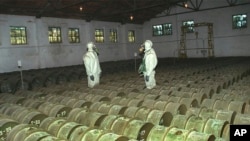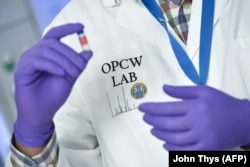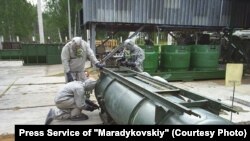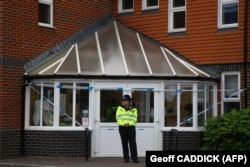Russia’s Foreign Ministry lashed out at the U.S. and Britain on Monday, August 13 following the announcement of new U.S. sanctions in connection with the Salisbury poisoning case.
The ministry’s official statement accused the U.S. of hypocrisy, pointing out that Russia eliminated its chemical weapon stockpile in 2017 while the U.S. has yet to fully dispose of its own stockpile. While this is partially true, the statement leaves out several important facts.
First, the direct comparison between Russian and the U.S. is not correct. Experts say the chemical weapons destruction in the U.S. is a complete process while in Russia “the destruction” can mean just the first stage, leaving behind massive amounts of highly toxic waste. We will return to this later on in the piece.
In the past, both Russia and the U.S. have missed their deadlines for destroying their chemical weapons stockpiles. While Russia claimed that it fully disposed of its declared stockpile by October 2017, the original deadline set by the Chemical Weapons Convention was 2007, which was then postponed to 2012.
It is important to note that by January 1, 2012, the U.S. had eliminated nearly 90 percent of its chemical weapons stockpile, with the remainder in two locations - Pueblo, Colorado, and Blue Grass, Kentucky. According to official estimates, the U.S. stockpile will be fully destroyed by 2023.
There are several reasons why destruction of the U.S. stockpile has taken considerably longer. To find out why, Polygraph.info contacted Paul F. Walker, Director for Environmental Sustainability at Green Cross International, who has personally inspected chemical weapons stockpiles and disposal processes in both Russia and the U.S.
“I think everyone believed and trusted the Russian declaration (of their chemical weapons stockpiles) which was made back in 1997 which was 40,000 tons give or take,” Walker said.
“There were seven very large stockpiles and I’ve been to every one of them. We worked with the Russians and the U.S. contractors and the global partnership to help the Russians move forward as quickly as possible,” he added.
According to Walker, most of these chemical weapons were stored “in bulk,” meaning in large storage tanks rather than “weaponized” inside the shelf of artillery ordnance or rockets. This is critical because it is far easier to neutralize and dispose of chemical weapons in bulk. Another key factor Walker mentioned was that the Russians agreed with the OPCW (Organization for the Prohibition of Chemical Weapons) on the criteria for determining how the chemical weapons were destroyed.
“All the stockpiles had to go through a two-stage process of destruction,” he said.
“They drain the weapons from the storage tanks and then mix it with hot water and sodium hydroxide and this neutralizes the live agent,” Walker continued. “And that meets OPCW needs for destroying the live agent. But it produces several tons of highly toxic chemical. So they have to go through a second stage process, which can be different things. It one case it can be incineration.”
Walker explained that Russia and the OPCW agreed that they only needed to complete the first stage on their stockpiles to consider them “destroyed.”
“If you define the destruction process as only first-stage, then they’ve completed the process. They’ve destroyed the whole stockpile. But if you define it as needing a second-stage process, then they far and away haven’t finished the process yet. In reality they still have a long way to go to finish the process -- clean up the toxic waste they’ve left,” he explained.
To give one example, Walker noted vast quantities of arsenic that have been left behind after the Russians neutralized a large stockpile of Lewisite, a WWI-era gas.
In the U.S., the process has been extremely difficult due to the fact that most of America’s chemical weapons stockpiles consist of the weaponized kind. Worse still, these artillery shells and rockets are not easily disassembled like Russia’s models.
“Most of those weapons have explosives and rocket propellants in them and it makes access much more dangerous for the workers,” Walker explained.
“Because of the complexity of the weapons and the danger involved, it’s taken a lot longer just for the construction of the buildings -- they need to have armored walls. There are explosions all the time in these ‘demil’ facilities, every month. It’s much more expensive,” Walker stated.
Walker also pointed out that there were major political battles over the issue of incineration and transportation of chemical weapons to proposed facilities which also prolonged the process.
The Russian Foreign Ministry’s connection of Salisbury with chemical weapons disposal also raises another question:If Russia really destroyed its chemical weapons stockpile, where did the Novichok used in the attempted assassination of ex-Russian spy Sergei Skripal come from?
According to Walker, the Chemical Weapons Convention (CWC) allows signatory countries to keep small samples for research purposes.
“When you look at Salisbury it’s pretty clear to most of us that it was Novichok and it was and assassination attempt,” he said.
“This whole incident in Salisbury which is kind of a bald-faced violation of the CWC really means that they had ongoing research, which is allowed under the CWC, but only with declared agents,” Walker told Polygraph.info. “Small samples, test tube sized dimensions are allowed. But you’ve got to declare everything you’re doing at those labs and what you have, otherwise it’s in violation of the CWC.”
Polygraph.info also sought comment from the U.S. State Department, which claimed that the Salisbury poisoning suggests Russia has not been fully transparent regarding its chemical weapons arsenal.
“The use of a Russia-produced chemical weapon in Salisbury provides evidence that Russia has not declared all its chemical weapons production facilities, its chemical weapons development facilities, and its chemical weapons stockpiles,” its statement said.
The statement also noted that the U.S. contributed both technical and financial support, the latter totaling over $1 billion, to Russia’s efforts to dispose of its declared chemical stockpile.









